Auke Visser´s Esso UK Tanker's site | home
SUPERTANKER ON TRIAL
The 'Esso Pembrokeshire', first of five 77,000 d.w.t. class tankers on order for the Company, was launched last
June. Before being handed over to the Company in October, she had to undergo stringent dock and sea trials.
This, the largest tanker ever owned by an oil company, completed her trials successfully and sailed on her maid-
en voyage from the Esso Refinery on Milford Haven to the Eastern Mediterranean in November.
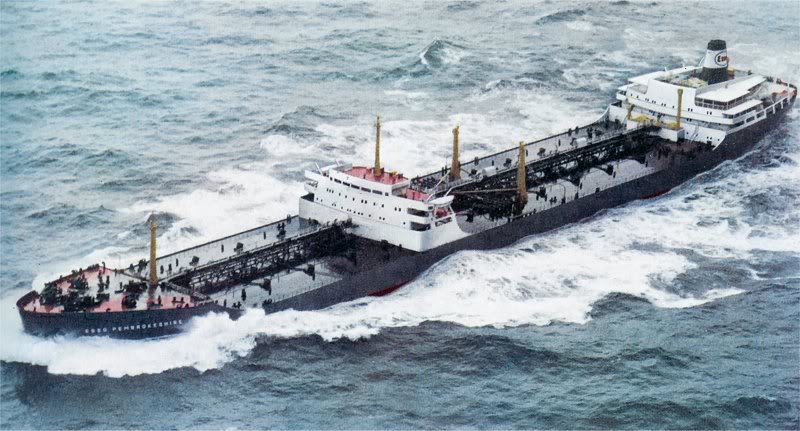
BEFORE any vessel is handed over from a shipyard to her owners she must first undergo dock trials and sea trials. To
begin with the machinery - boilers, steam turbines and all auxiliary equipment - must be tested before the ship can safely
put to sea. Inclining tests must be made to determine her initial stability; compasses and radio-direction equipment must
be adjusted; and the steering gear tested.
Last October, the Esso Pembrokeshire, first of five 'County Class' tankers on order for the Company, underwent her trials
in the North Sea. But before we describe those trials, what sort of ship is she ? She is the largest tanker ever owned by an
oil company and has a bigger displacement than any ship ever to berth at an English port.
With a deadweight of 79,500 tons, a displacement of 100,000 tons and a cargo capacity of nearly 77,000 tons of oil, the
Esso Pembrokeshire is 856 feet long and has a moulded breadth of li2i feet. She is powered by steam turbines of 26,500
shaft horsepower and is capable of a speed of over 17 knots. She has a loaded Summer draught of 47 feet (n feet more
than the present maximum draught permitted in the Suez Canal) and is now in service between the Eastern Mediterran-
ean ports and the Esso refinery on Milford Haven. Her cargo pumps are of very high capacity and are capable of discharg-
ing a full cargo of oil in about 16 hours.
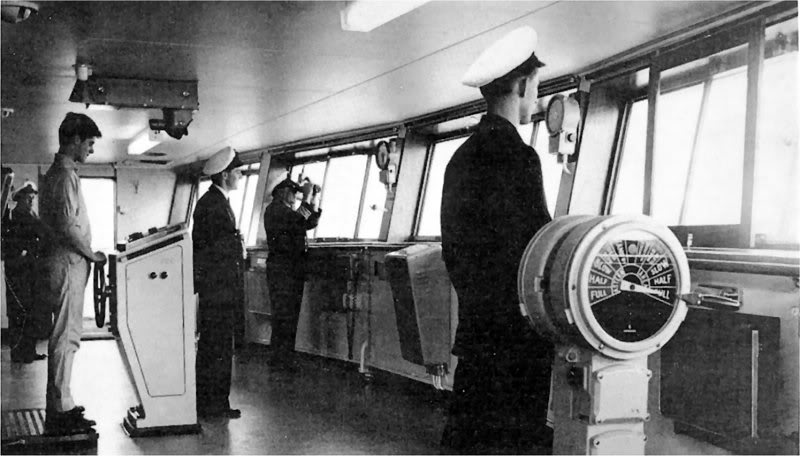
The Navigation bridge of the Esso Pembrokshire.
Each member of the crew has his own cabin with hot and cold water, and the cabins, like the mess and recreation rooms,
are fully air-conditioned. Every officer and petty officer has a private bathroom, and for other crew members there is one
bathroom to every two men. As well as being one of the most efficient ships in the British Mercantile Marine, the Esso
Pembrokeshire is also one of the most comfortable. Her accommodation includes a swimming pool as well as facilities
for film showings.
About a week before the new ship left her builders, dock trials were carried out; steam was raised in her two boilers; and
her main turbines and auxiliary machinery were tested. While tied up alongside a quay it is impossible to run main engin-
es at full speed, but sufficient power can be obtained to ensure that the machinery will operate successfully when the
ship leaves the shipyard for sea trials. At the same time an inclining experiment is carried out. This is a most important
check to determine the
stability of the vessel, and consists in heeling the ship over to various small inclinations by means of moving weights ac-
ross the decks and recording the amount of weight moved, and the angle of heel in each case. This is a test so old that
it could even have been used on the Ark, but no better method has yet been found. The ship's displacement is also noted.
Everything having proved satisfactory, the Esso Pembrokeshire sailed to Bremer-haven, arriving there on 20th October.
After docking for bottom scraping and painting, and general examination of the under-water hull, she left Bremerhaven on
24th October, passing the Weser light vessel at about n.oo hours. About one hour was spent in this area while anchoring
manoeuvres were carried out and the radio direction finder and compasses adjusted. Extra ballast was taken into the
cargo tanks to bring her down to a draught of 46 feet 10 inches.
Early that afternoon the Esso Pembrokeshire left for the trial area of Kristiansund, off the South coast of Norway, where
the sea trials were to take place. During the first night at sea, endurance trials at different powers were carried out. In the-
se trials the shaft horsepower developed by the steam turbine propelling machinery was carefully measured by highly ac-
curate instruments, and records were taken from the turbines and boilers every half hour.
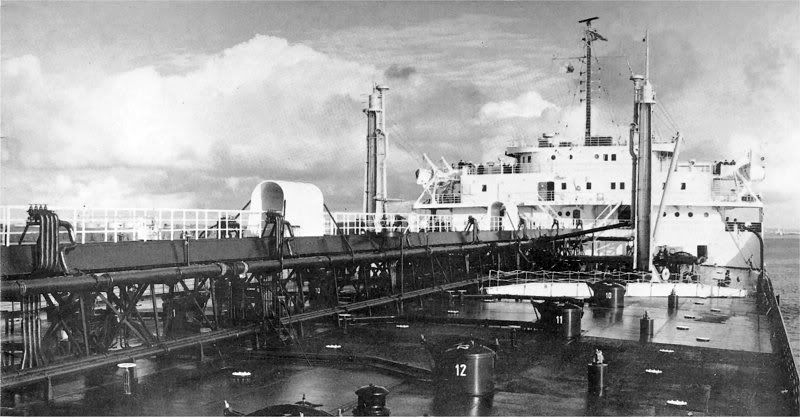
Looking forward along the upperdeck towards the bridge.
By 08.00 hours next morning the trial area was reached and speed trials were started. Many ships' speeds were deter-
mined by the use of established lengths of one nautical mile laid off along a shore and marked at its termini by specially
placed landmarks. But today, for speed trials, more and more use is being made of the Decca Navigator system, from
which a very high degree of accuracy may be obtained. This system enables the position of a ship to be plotted on a
chart to within about 30 feet by means of receiving radio transmissions sent out by a chain of stations. For sea trials, a
refined usage of the Decca Navigator system is employed within a number of carefully chosen areas that have been
picked for a combination of their suitability with regard to the transmitting stations, and their convenience to the major
shipyards. Areas at present available for such trials are to be found off the North-East coast of Ireland, the Isle of Man,
Bristol Channel, Newbiggin, North Sea, Fame Deep and Kristiansund.
Speed trials of the Esso Pembrokeshire started with runs under different propelling machinery conditions, with outputs
of about 19,300, 24,100 and 26,500 shaft horsepower. Each set of tests consisted of three consecutive runs. In the
case of speed trials by Decca, there are usually four runs on reciprocal courses, in each of which 20 positions are plot-
ted at intervals of 30 seconds. From these positions a speed is calculated for each run and the final result obtained.
This first set of tests was followed by an endurance and economy trial at full power. An average daily fuel consumption
for a vessel of this size is about 135 tons of oil.
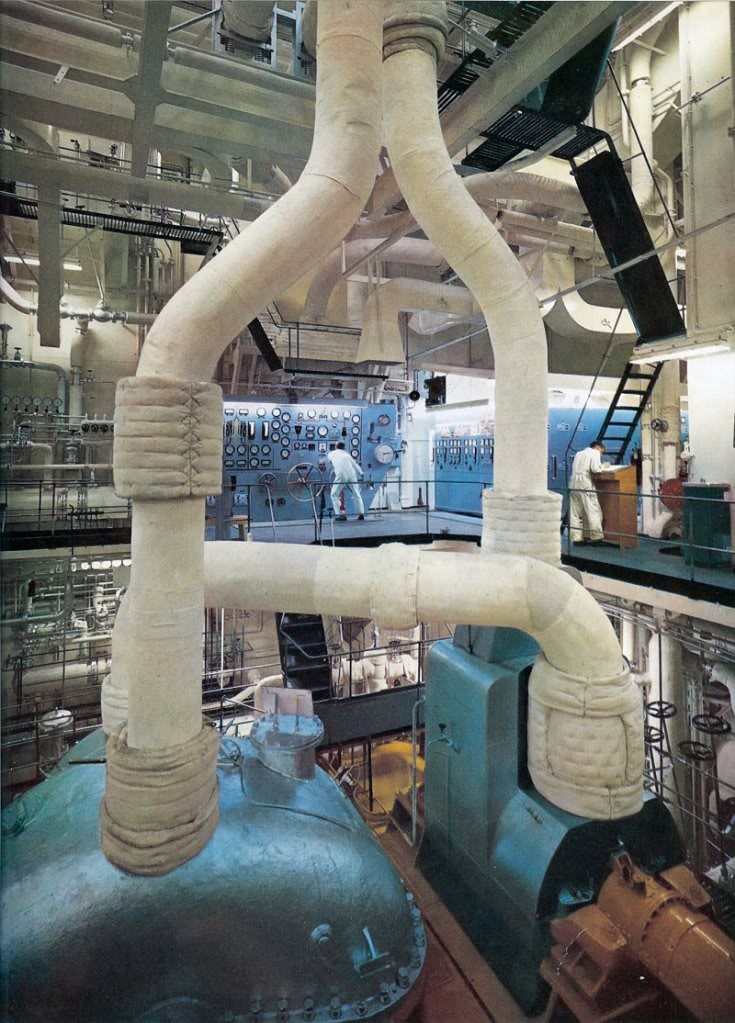
The engineroom of the Esso Pembrokeshire.
From late that night until 07.00 hours the following morning three more sets of trial speeds were carried out under similar
circumstances. At 08.00 hours manoeuvring trials and tests were started. These consisted of a number of tests with the
steering gear, including turning circles to port and to starboard; zig-zag manoeuvres to find the response of the ship to
small angles of helm; full ahead and full astern manoeuvres; and emergency stops. It is of interest to note that the Esso
Pembrokeshire can make a turn to port at full speed within just under four times her length. The starboard turn can be
made in a little less than five lengths, using more water on account of the fact that the propeller is of right hand rotation.
On completion of these tests the ship was headed back for the Weser, and at 20.00 hours discharging ballast was start-
ed.
After the ballast was discharged the ship returned to Bremerhaven where she was berthed prior to the handing over ce-
remony. On Wednesday, ist November, tugs drew her away from the quayside and the voyage to Milford Haven began.
On board were representatives of the owners, a few subcontractors' representatives and, of course, the ship's own
crew, some of whom were new and others who had sailed together for many years. Captain E. Tyrrell, Commodore of
the Esso Fleet, was in command. During this voyage a further series of tests was carried out, including emergency
stops and running under different conditions of ballast.
Emergency stops, as can well be understood, are most important, as it is essential that the master should know how
much sea space is required to bring his ship to a standstill. 'Crash stops' are fortunately seldom necessary but are an
important feature of all sea trials. For these manoeuvres the Decca Navigator is again used for noting the distance tra-
velled. One example noted was that at a speed of 17 knots it took 12 minutes to bring the ship to a standstill, by which
time she had travelled less than a mile.
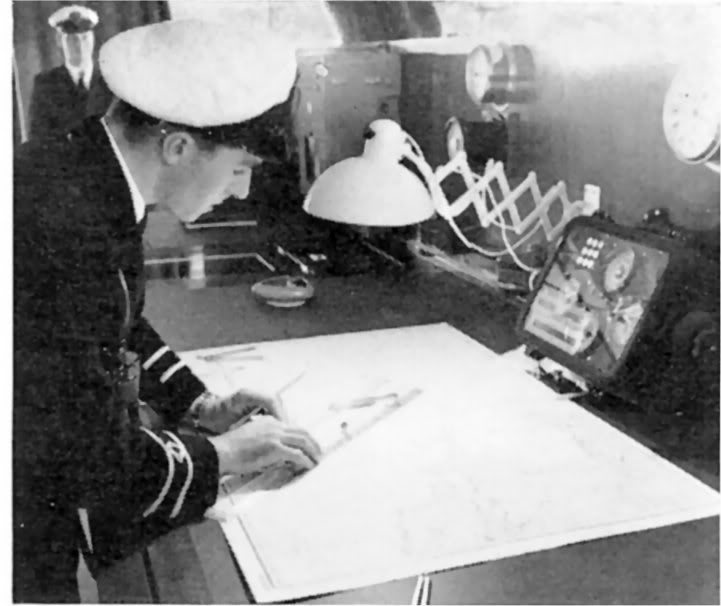
Plotting the position of the ship with the aid of the Decca Navigator.
On Saturday morning the Esso Pembrokeshire lay off the Esso refinery on Milford Haven, and most of the trial party
who had taken part in the trip left for home. It had been a good test for the ship without any serious hitches. The mach-
inery ran well, which pleased the engineers; and there was no vibration, which made the naval architects happy. The
Esso Pembrokeshire had come through her trials successfully. Now her useful life was to begin. She sailed on her
maiden voyage in November to the Eastern Mediterranean to collect her first cargo of energy - energy in the form of
crude oil, which this country needs in growing quantities, and which these very big ships can bring to us in greater
quantities at less cost per ton than before.
Therein lies the reason and the justification for their existence. They are working models of that over-worked word
'productivity'.
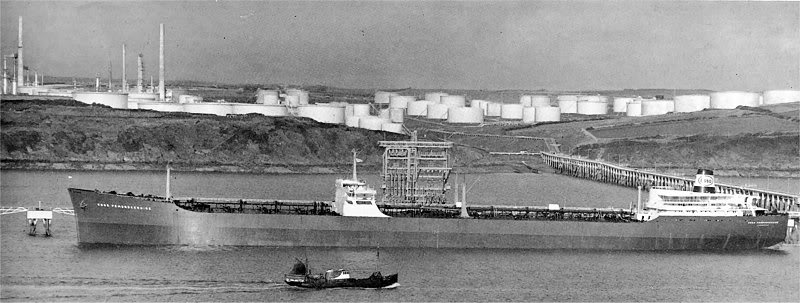
After her successful trials, the Esso Pembrokeshire was handed over to the Company and is here
seen berthed at the marine terminal of the Esso refinery on Milford Haven.
( Article and photos thanks to Jullian Lelliott )